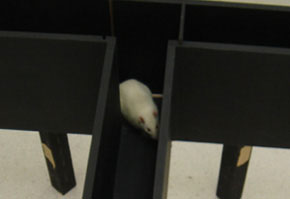

The results were published in both NeuroImmunoModulation and Physiology & Behavior
The results were published in both NeuroImmunoModulation and Physiology & Behavior.
The results were published in both NeuroImmunoModulation and Physiology & Behavior.

The results were published in both NeuroImmunoModulation and Physiology & Behavior
By Karina Toledo
Agência FAPESP – Scientists from Universidade de São Paulo (USP) have managed to induce an effect similar to autism in rat offspring by injecting pregnant rats with Escherichia coli, creating an animal model of the disease that could be useful in several studies.
The study – one of the winners of the most recent USP Outstanding Thesis Award (Prêmio Tese Destaque USP) – began with Thiago Berti Kirsten’s master’s thesis and concluded with his doctoral dissertation; both were supported by FAPESP fellowships.
“Our greatest contribution was showing that in addition to those well-established genetic factors, infections during gestation are also important in the etiology of mental disease. Our findings indicate that a bacterial infection in the middle of gestation could induce behavioral alterations similar to autism, affecting communication, socialization and cognitive inflexibility,” said Kirsten.
The experiment consisted of injecting a toxin called lipopolysaccharide (LPS), which was extracted from the bacterial membrane of E. coli, into rats on day 9.5 of gestation. According to Martha Bernardi, a researcher at the School of Veterinary Medicine and Zootechny (FMVZ) at USP and lead on the study, this would be equivalent to a woman getting food poisoning during the fourth month of pregnancy.
The mice have a discrete and temporary sickness state after the infection, but they soon return to their normal state and take care of their offspring adequately. However, in the offspring, the effects were greater and longer lasting.
“After delivery, we left the rats with eight offspring: four females and four males. All the females had normal behavior. The males, on the other hand, showed a lower preference for their mother’s smell, an indication of reduced maternal recognition, and a reduction in socialization through play. As autism is also much more common in men than women – four to one – the difference observed among males and females is strong evidence that we managed to create a model of the disease,” evaluated Bernardi.
The results on the reduced capacity for socialization were published in NeuroImmunoModulation. Data on the difficulty in recognizing the mother by smell were released in Physiology & Behavior.
When studying the brains of affected animals for his master’s thesis, Kirsten observed that the production of dopamine – a neurotransmitter involved in controlling movement, learning, humor, emotions and cognition, sleep and memory – was diminished. The results were published in the Journal of Neuroscience Research.
According to Bernardi, previous studies had related autism solely to a deficiency in serotonin. “We were the first to relate the condition to a dopaminergic hypofunction. However, it is worth noting that we only studied one of the forms of autism, the one induced by inflammation. This syndrome, however, is multifactorial and can have genetic causes, and medication and other factors can be involved,” he said.
During his doctorate, Kirsten studied dopamine receptors in the brains of rats and observed that they were unaltered. However, he discovered that the necessary enzyme for dopamine production– a tyrosine hydroxylase – was reduced. Upon examination of other neurotransmitters, he did not find relevant alterations.
“We believe that bacterial toxins induced the release of inflammatory cytokines that cause a functional lesion in the brains of rats. The brain tissue and the glial cells of the offspring, however, were normal,” said Bernardi.
Also during his doctorate, Kirsten used an ultrasound device to show that male babies had communication problems. “When we take the mother away from her babies, they normally begin to scream for her to come back. However, in the males, this communication was reduced. Furthermore, they presented the repetitive behavior typical of autism,” explained Bernardi.
According to Bernardi, other groups are using the animal model developed by Kirsten to investigate, for example, pain perception in autism. “We don’t know for sure if patients with the disease feel more or less pain than normal and simply express less pain,” affirmed Bernardi.
To Kirsten, the model is interesting for the scientific community because it is easily replicated and because it faithfully reproduces several aspects of autism.
“The next step is to conduct interventions in the offspring after the maternal infection while they are still gestating with substances that interfere in the immune system and reverse the neurological damage. We hope to find future interventions to attempt to lessen or even reverse the losses caused by autism,” said Kirsten, who is currently doing post-doctoral studies, also with a FAPESP fellowship, under the supervision of Professor Luciano Freitas Felício, at FMVZ-USP.
Created to stimulate research activities between students and graduate students, USP’s Outstanding Thesis Award evaluated theses in nine fields of knowledge. The author of the best work in each area receives R$ 15,000, and their advisers receive R$ 10,000. The works receiving honorable mentions are awarded R$ 5,000 each. Several of the award-winning theses had FAPESP funding.
Republish
The Agency FAPESP licenses news via Creative Commons (CC-BY-NC-ND) so that they can be republished free of charge and in a simple way by other digital or printed vehicles. Agência FAPESP must be credited as the source of the content being republished and the name of the reporter (if any) must be attributed. Using the HMTL button below allows compliance with these rules, detailed in Digital Republishing Policy FAPESP.





